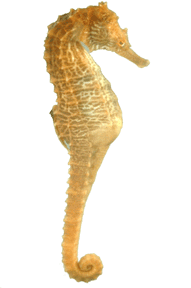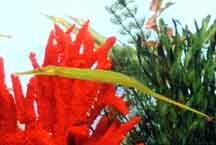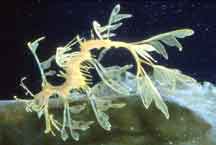 With the new show at the National Aquarium in Baltimore, you can get up close and personal with these remarkable fish. But that’s not the only locality seahorses roam.
With the new show at the National Aquarium in Baltimore, you can get up close and personal with these remarkable fish. But that’s not the only locality seahorses roam.
story by Rachel Presa
The view through the curved glass, most of the day, reveals a hovering blur of colors. Blue, pink, red and yellow blobs, each topped with a smaller blob, some light, some dark. Their movements are jerky, and flashes of light pop at irregular intervals. Keeping your left eye on the glassy and mysterious outer fringes, you turn your right one to the world inside the glass, where everything seems a little slower and smoother. Plants float gracefully with the movement of the water, and tiny bubbles dance up toward the surface. Squirming brine shrimp dot the lower regions of the tank. As one swims in front of you, your head darts out reflexively. shlurrp! It disappears through your tubelike mouth.
If that’s your view, you are a seahorse starring in the Baltimore National Aquarium’s latest exhibit, Seahorses: Beyond Imagination. You share the exhibition hall, which houses nine tanks holding 4,200 gallons of water, with hundreds of close and distant relatives: some 18 species of seahorses, seadragons and pipefish. Your relations - all members of an exotic and diverse family that scientists call the syngnathids - have come from all over the world. Traveling perhaps the shortest distance to represent Chesapeake Country is hippocampus erectus, the lined seahorse, who swims in our diminishing coastal eel grasses alongside our celebrated blue crabs and oysters.
Some are tiny: The adult dwarf seahorse, from the Bahamas, is only an inch long. Some are large, like the Australian potbelly, with a stomach to suit its name, which can grow to over a foot. Some tend to be showy: The weedy and leafy seadragons, who live in the kelp beds of Tasmania and Australia, look like psychedelic plants, their beauty so rare and so extreme as to make them seem awkward and vulnerable. Next to these vibrantly flamboyant dragons, the simpler Chesapeake lined and Philippine Barbour’s seahorses seem like down-to-earth country cousins.
Diverse though they may be, the seahorses share characteristics that make even the plainest stand out in comparison with your everyday swimmer. Likewise, the serious environmental threats that are diminishing their population are in sharp contrast to the fanciful image of these mysterious animals.
Seahorses are covered not with scales, like most fish, but with a bony plate of armor, which protects them from predators. In some species, this bony plate makes the body semi-rigid. Because of this, seahorses don’t move their body in a wavelike fashion like most fish. Instead, they glide gracefully up, down, around and through water by fanning their delicate fins.
Seahorse family traits include an array of other curiosities. They can change color to blend with their surroundings. They can willfully grow ornamental head decorations when they want to show off their power or virility. They have prehensile tails, which they use to hang onto objects, to fight and to show affection. Their eyes move independently of each other, which helps them to avoid predators and find food. They lack both teeth and stomachs, sucking food through their bony snout in enormous quantities (about once a minute) to compensate for their fast and inefficient digestion.
 Lives Full of Love and Danger
Lives Full of Love and Danger
The lights have just come up to start the day. Outside the glass all is still, as it is too early for the regular crowds of spectators. You come down from your evening perch, a piece of coral, and swim all around the tank, looking for your partner, the one you have chosen to mate with during this season. When you find each other, you both flush to shimmering white, then you link tails and dance together in a synchronized pattern. Outside the tank, a group of royal blue blobs (the Aquarium staff wears the same color every day) briefly gathers, then moves on.
“We see it every morning in the tanks, shortly after the lights come on,” says Allison Scarratt, curator of fishes at the National Aquarium. “We go up there and there’s just a tangle of seahorses going through their daily courtship dance.”
Seahorses are believed to be monogamous, forming pair bonds that last at least for the duration of the mating season, if not from year to year. Monogamy is not uncommon in the animal kingdom, but seahorse reproduction takes partnership to a whole new level.
In seahorse pairs, males become pregnant, carry and incubate the developing babies, then bear the fully formed offspring when the gestation period is over 10 to 30 days later, depending on species. Females produce the eggs, but when the male is potent, she uses her repositor, a tubelike organ, to pump the eggs into the male’s pouch. The daily courtship dance helps to synchronize the mating cycles of the partners. When both are ready, the male will fill his sack with air, expanding and opening it to say to the female, as explained by Scarratt, ‘Hey, look at my big, empty pouch!’ Then the dance develops into the actual mating act.
Different species of seahorses reproduce at different rates. Some incubate thousands of tiny newborns; others only a few, which are larger and tougher. Because conditions in the Aquarium are so ideal, the animals there reproduce all the time, far more than they would in the wild. In the Aquarium, almost all the newborn seahorses grow up to be healthy, reproducing adults. But in the wild, many of the young, especially the tinier ones, would be eaten by predators or carried off by the tides before they could reach maturity.
Natural selection, however, is not the greatest hazard to seahorse populations. Humans are.
“They’re getting a triple whammy,” says Glenn Page, director of conservation at the Aquarium. Page is referring to the three great threats affecting the lives of these animals, several species of which are on the International Union for the Conservation of Nature Red List of threatened animals. Coastal development and fishing, which destroy habitat; commercial catching for home aquariums; and the popularity of the creature as a remedy in Asian traditional medicines press the world’s seahorse population from three sides.
At least one species is critically endangered, and 35 species are considered vulnerable. The scant handful of species not on the Conservation list are absent because of a lack of information, but the trend indicates that they are probably in peril as well. In seahorse habitats where one or two of the major threats don’t exist, you can bet the other is in full force.
Chesapeake Bay seahorses are in the same boat with crabs and oysters, coastal dwellers pushed out of their homes by development, pollution and commercial fishing practices of dredging the Bay bottom, taking not only catch but their homes as well.
“We really have no idea how many seahorses are in the Bay,” says Page. Because seahorses are not a fishery resource, nobody is out there counting, keeping track or studying their status. Scientists like Page do know where to find them: Chesapeake lined seahorses and their close relatives, the northern pipefish, reside in the coastal eel grass beds, at their thickest in high salinity areas, from the mouth of the Patuxent River down to Virginia Beach.
But eel grass beds have been steadily disappearing as the area becomes more populated and the coastal market more lucrative. Along with destructive dredging, chemical runoff from building, fertilizing and everyday human activity deposit nutrients into the water. Overfed algae cover the water’s surface, depriving the eel grasses of light and oxygen, and in effect, asphyxiating them.
A seahorse who loses his home bed is as good as doomed, since the animals spend their lifetime faithful to an area of about one square yard of Bay.
“We now have only about 10 percent of the eel grass beds we had when Captain John Smith sailed up the Chesapeake,” estimates Page. “If we’ve lost 90 percent of their habitat, you can assume that we’ve probably lost 90 percent of the seahorses.”
 Calvert’s Seahorse Fold
Calvert’s Seahorse Fold
Bay seahorses do get some breaks, however. Nobody is out there fishing exclusively for seahorses in the Bay, as they are in great numbers in Indonesia and elsewhere. There is some by-catch; the occasional crabber might pull up an unexpected visitor in his pot, but in Calvert County at least, this might be a lucky fate.
This year, Aquarist Carin Stringer, of Calvert Marine Museum, put the word out to area watermen that she would adopt stray seahorses that got caught in their pots. Stringer has been at the museum since 1994, when she started as a high-school intern. Now a full-time staffer, she is the sole caretaker of the seahorse research and breeding program there. Stringer began experimenting with the animals in high school; she is now one of a few experts on the species.
“Some seahorses are easy to raise; some are really hard. Chesapeake’s are some of the hard ones,” explains Stringer, who is having a particularly good year. In her care are 36 full-grown seahorses, including one giant, estimated at seven years old, who has been at the museum since 1997, outliving the typical seahorse by four years. Last year, she recalls, eight or 10 of the 300 babies born in the museum survived; this year; she boasts an 80-percent survival rate. A batch of March newborns is already breeding; usually, lined seahorses grow for about a year and a half before they reach sexual maturity.
With the museum’s syngnathid population at its most prosperous ever, Stringer looked to the watermen to increase her numbers and found them eager to help. So far, 10 newcomers have moved into the museum.
With such great success in breeding the animals, Stringer would like to try reintroducing some of her friends into healthy eel grass beds along the coast. But first she has to surmount the Maryland Department of Natural Resources, which, she explains, “is very strict about releasing animals into the wild when they’ve been in captivity.”
 On the Seahorse Farm
On the Seahorse Farm
The glass is flat, and outside, there is bright fluorescent light, instead of the darkness of the exhibit, where the light emanated from inside the tanks. Here the world is smaller and simpler; gone are the bright coral and sprawling leaves of thick underwater vegetation, and your view of the world outside the glass is sometimes blocked by a hanging clipboard. The figures that sidle up outside the tank belong to staff with capable hands that sometimes reach into the water to tie on an identification tag or to stretch out your curled tail for a measurement. And, as always, there is food … shlurrp! A bright red brine shrimp, soaked in nourishing vitamin supplements, is no longer for this world.
“Seahorses recognize us with the blue shirts. If we are in front of the tanks at feeding time, they come to the window and look at us. And the leafy seadragons all the time are looking at the public; they’re always at the front of the tank, looking out.”
Jorge Gomezjurado - originally of Ecuador, formerly of both the Charles Darwin Research Center in the Galapagos Islands and San Francisco’s Steinhart Aquarium - may be the human most widely recognized by seahorses and seahorse researchers alike. Since early 2000, the Aquarium in Baltimore has been home base for the syngnathid expert, where, as husbandry lead, he has the responsibility of caring for the hundreds of stars of the exhibit.
The seahorse support laboratory in the Columbus Center on Pratt Street, a short walk from the exhibit, is where Gomezjurado (just call him Jorge) spends his days. The lab is backstage to the exhibit, the place where tiny, baby seahorses are incubated until they have reached more sustainable maturity levels. Here, too, a sick seahorse might go for some TLC or a lagging batch for some R&R before returning to the main exhibit. It is a controlled environment where Jorge and the other aquarists, volunteers and interns who work on the exhibit keep careful track of the animals’ daily lives.
The seahorses being raised in Baltimore will probably never live in the wild. Instead, they will remain in the limelight, traveling around the country to other Aquariums after the exhibit is over.
Toward a World Safe for Syngnathids
As well as supplying Beyond Imagination with its stars, the Columbus Center lab is playing a part in assuring the future of these rare and remarkable fish.
“The goal for the lab is to breed animals to share with other aquariums, to alleviate fishing pressures in the wild,” explains Jorge. As part of the American Zoo and Aquarium Association, the aquarists in Baltimore are responsible for two species of seahorse, the Pacific giant and the yellow. They keep track of captive breeding, trade and sale, and they supervise the health and care of these two species within the aquarium circuit. “If we can get the budget, we will also do research in the wild,” says Jorge.
The two species Baltimore’s Aquarium watches over are from the far-off Pacific; they also take a special interest in the fate of the natives. A member of the Chesapeake Bay Program, the Aquarium is perpetually active in conservation efforts.
Restoring habitat for coastal dwellers like seahorses is high on the list of priorities for Bay activists. In thriving areas where water quality has improved enough to replant eel grasses, the Aquarium is working within the Bay Program to kick-start the recovering ecosystems. “Staff and volunteer divers are doing direct transplanting of grasses and measuring the success,” explains Page. “These grasses would probably come back naturally over the years, but we don’t have the luxury of time.”
Seahorse researchers at the Aquarium are also finding that it’s a two-way street. Just as seahorses depend on eel grass, so may eel grass need seahorses. Grasses become gunky when there are too many nutrients in the water. Grasping seahorse tails may help keep blades clean and able to photosynthesize. “There may be a synergistic effect,” says Page. “If so, that would be cool, new information. We don’t know, but we’re considering it.”
In the Aquarium, raising awareness goes hand-in-hand with raising eyebrows. Tear your eyes away from the tanks, and you’ll see that the exhibit walls are full of charts, diagrams and photographs that let you know just how dear these creatures are. On your way out of the hall, leave your e-mail address at the interactive computer terminal to join the campaign.
You wander through the exhibit, your eyes widening as you witness the flowing appendages of the leafy seadragon. You giggle at the expressive rocking motion of the swimming Barbour’s seahorse. You stop and stare, becoming absorbed in the movements of two potbellies: Are they fighting? Are they embracing? Whoops! You wobble, then regain your balance as an unruly child rushes past your legs.
If this is your view, you are a human, entranced with the seahorses at the National Aquarium in Baltimore.
You share the exhibition hall - which houses nine tanks holding 4,200 gallons of water and 18 species of seahorses - with a culturally and diverse, nearly unnavigable crowd of visitors of all ages. Your neighbors seem to be as enthralled as you are with the lovely animals. You take your time despite the crowd, trying to give full attention to each member of this widely varied, brilliant family of marine animals.